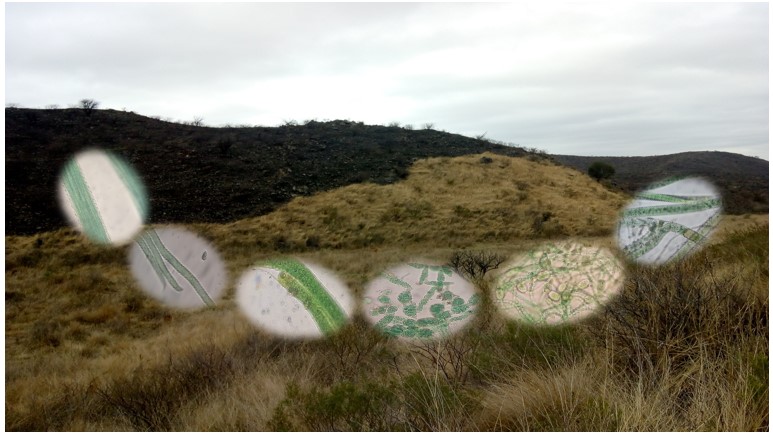Edaphic cyanobacterial community of post-fire soils in Sierras Chicas of Córdoba province, Argentina
DOI:
https://doi.org/10.30972/bon.3317217Keywords:
Cyanobacteria, fires, nutrients, soilAbstract
Cyanobacteria are oxygenic phototrophic organisms that possess a high adaptive capacity to different environments, allowing them to pioneer terrestrial ecosystems. The objective of this study was to compare the cyanobacterial community in two areas of secondary mountain forest: one seven days after a fire (post-fire soil) and another nearby without fire (control soil). The collected samples were cultivated for 8 weeks under controlled conditions. A total of 35 taxa were identified: 2 unicellular, 24 filamentous without heterocytous, and 9 with heterocytous cyanobacteria; 13 of them represent the first record for soils in Córdoba. Microcoleus vaginatus was the most frequent taxon, along with Scytonema hoffmannii, Desmonostoc muscorum, and Nostoc commune, which persisted until the end of the experiment. The presence of exclusive organisms such as Calothrix brevissima, Chlorogloeopsis fritschii, and Cylindrospermum muscicola in the control soils highlights their sensitivity to this type of disruptive event in the community. The availability of nitrogen, CO content, and pH are the physicochemical soil variables that define the community structure. This work is contributing to increase our knowledge of soil restoration after forest fires.
Downloads
References
Arana, M. D., Natale, E., Ferretti, N., Romano, G., Oggero, A., Martínez, G., Posadas, P. & Morrone, J. J. (2021). Esquema biogeográfico de la República Argentina. Opera lilloana 56, Fundación Miguel Lillo, Tucumán, Argentina.
Argañaraz, J. P., Gavier Pizarro, G., Zak, M., Landi, M. A. & Bellis, L. M. (2015). Fire regime, climate, and vegetation in the Sierras de Córdoba, Argentina. Fire Ecology 11: 55-73. https://doi.org/10.4996/ fireecology.1101055.
Bray, R. H. & Kurtz, L. T. (1945). Determination of total, organic and available forms of phosphorus in soil. Soil Science 59: 39-45.
Виноградова, О. Н. & Михайлюк, Т. И. (2018). О Таксономии И Номенклатуре Некоторых Наземных Представителей Рода Plectonema s. l. (Cyanophyceae). 1. КАЗУС Plectonema edaphicum 28: 237-254.
Bremner, J. M. (1996). Nitrogen - Total. En Sparks, D. L. (ed.), Methods of Soil Analysis. Part 3 - Chemical Methods. Chapter 37, pp. 1085-1112. ASA, SSSA, CSSA, Madison. https://doi.org/10.2136/sssabookser5.3.c37
Büdel, B., Dulić, T., Darienko T., Rybalka, N. & Friedl, T. (2016). Cyanobacteria and algae of biological soil crusts. En Weber B., B. Büdel & J. Belnap (eds.), Biological soil crusts: an organizing principle in drylands, Ecological Studies 226, pp. 55-80. Springer International Publishing, Cham.
Cabrera, A. (1976). Regiones fitogeográficas argentinas. 2ed. Enciclopedia Argentina Agricultura y Jardinería. ACME, Buenos Aires.
Cabido, M., Carranza, M. L., Acosta, A. & Páez, S. (1991). Contribución al conocimiento fitosociológico del Bosque Chaqueño Serrano en la provincia de Córdoba, Argentina. Phytocoenología 19: 547-566.
Caon, L., Vallejo V. R., Ritsema, C. J. & Geissen V. (2014). Effects of wildfire on soil nutrients in Mediterranean ecosystems. Earth-Science Reviews 139: 47-58.
Certini, G. (2005). Effects of fire on properties of forest soils: a review. Oecologia 143:1-10.
Chua, J., Orlovich, D. & Summerfield, T. (2014). Cyanobacteria in New Zealand indigenous grasslands. New Zealand Journal of Botany 52: 100-115.
Cingolani, A. M., Vaieretti, M. V., Giorgis, M. A., La Torre, N., Whitworth-Hulse, J. I. & Renison D. (2013). Can livestock and fires convert the subtropical mountain rangelands of central Argentina into a rocky desert? The Rangeland Journal 35: 285-297.
Concostrina-Zubiri, L., Martínez, L., HuberSannwald, E. & Escudero, A. (2013). Efectos y respuestas de la costra biológica del suelo en ecosistemas áridos: avances recientes a nivel de especie. Ecosistemas 2: 95-100. https://10.7818/ ECOS.2013.22-3.13.
Corbalán, M., Hladki, A. I. & Biasuso, A. B. (2017). Evaluación del deterioro antrópico y biológico en el petroglifo Piedra Pintada, San Pedro de Colalao, provincia de Tucumán. Cuadernos del Instituto Nacional de Antropología y Pensamiento Latinoamericano- Series Especiales 5: 1-16.
Denegri, A., Fernández Belmonte, M. C. & Campitelli, P. (2021). Cianobacterias como restauradoras de suelos incendiados: un caso de estudio en zonas semiáridas del centro-oeste de Argentina. Multequina 30: 99-114.
Di Rienzo, J., Balzarini M., Gonzalez, L., Casanoves, F., Tablada, M. & Robledo, C.W. (2018). InfoStat/L software estadístico. Universidad Nacional de Córdoba (FCA-UNC).
Flores Melo, X., De La Rosa, N., Wenzel, M. & Díaz, M. (2019). Cianobacterias ácido-termófilas del complejo termal Copahue, Neuquén, Argentina. Darwiniana, nueva serie 7: 39-56.
García-Pichel, F., Belnap J., Neuer, S. & Schanz, F. (2003). Estimates of global cyanobacterial biomass and its distribution. Algological Studies 109: 213- 227.
Giorgis, M. A., Cingolani, A. M. & Cabido M. (2013). El efecto del fuego y las características topográficas sobre la vegetación y las propiedades del suelo en la zona de transición entre bosques y pastizales de las sierras de Córdoba Argentina. Boletín Sociedad Argentina Botánica 48: 493-513.
Guiry, M. D. & Guiry, G. M. (2020). AlgaeBase. Worldwide electronic publication, National University of Ireland, Galway. http://www.algaebase.org.
Guarrera, S. A. & Echenique, R. O. (1998). Cyanophyta: Hormogonophyccideae, en Flora Criptogámica de Tierra del Fuego. Tomo 1- Fasc. 2, pp. 1-93. CONICET, Buenos Aires.
Gurvich, D. E., Enrico, L. & Cingolani, A. M. (2005). Linking plant functional traits with postfire sprouting vigour in woody species in central Argentina. Austral Ecology 30: 789-796.
Halder, N. (2016). Note on taxonomy of Chlorogloeopsis fritschii (Mitra) Mitra & Pandey with soil analysis, collected from a rice field in West Bengal. India Our Nature 14: 92- 98. http:// dx.doi.org/10.3126/on.v14i11644.
Kömárek, J. & Anagnostidis, K. (1999). Cyanoprokaryota 1. Teil: Chroococcales. En Ettl H., G. Gärtner, H. Heynig & D. Mollenhauer (eds), Süsswasserflora von Mitteleuropa 19/1, Gustav Fischer, Jena-Stuttgart-Lübeck-Ulm.
Kömárek, J. & Anagnostidis, K. (2005). Cyanoprokaryota 2. Teil. Oscillatoriales. En Büdel, B., Krienitz, L., Gartner, G. & M. Schagerl (eds.), Süβwasserflora von Mitteleuropa 19/2. Elsevier/Spektrum, Heidelberg.
Kömárek, J., Sant´Anna, C. L., Bohunická, M., Mareš, J., Hentschke, G. S., Rigonato, J. & Fiore, M. F. (2013). Phenotype diversity and phylogeny of selected Scytonema-species (Cyanoprokaryota) from SE Brazil. Fottea 13: 173-200.
Kömárek, J., Kaštovský, J., Mareš, J. & Johansen, J. R. (2014). Taxonomic classification of cyanoprokaryotes (cyanobacterial genera) using a polyphasic approach. Preslia 86: 295-235.
Luti, R., Bertrand De Solis, M. F., Galera, M. F., Muller De Ferreira, N., Hereal, M., Nüres, H., Herrera, M. A. & Barrera, J. C. (1979). Vegetación. En Vázquez J. B., Miatello, R. A. & M. E. Roqué (eds.), Geografía Física de la Provincia de Córdoba, pp. 369-434. Ed. Boldt, Buenos Aires.
Mager, D. M. & Thomas, A. D. (2011). Extracellular polysaccharides from cyanobacterial soil crusts: a review of their role in dryland soil processes. Journal of Arid Environments 75: 91-97.
Mataix-Solera, J., Arcenegui, V., Guerrero, C., Mayoral, A. M., Morales, J., González J., García-Orenes, F. & Gómez, I. (2007). Water repellency under different plant species in a calcareous forest soil in a semiarid Mediterranean environment. Hydrological Processes 21: 2300- 2309.
Muhlsteinova, R., Johansen, J. R., Pietrasiak, N., Martin, M. P., Osorio-Santos, K., & Warren, S. D. (2014). Polyphasic characterization of Trichocoleus desertorum sp. nov. (Pseudanabaenales, Cyanobacteria) from desert soils and phylogenetic placement of the genus Trichocoleus. Phytotaxa 163: 241-261.
Mulvaney, R. L. (1996). Nitrogen-Inorganic forms. En Sparks, D. L. (ed.), Methods of Soil Analysis, Part 3 - Chemical Methods. Chapter 38. ASA & SSSA, CSSA, Madison WI.
Murialdo, R., Fernández Belmonte, M. C., Daga, I. C., González, C. & Pesci, H. E. (2019). Contribución al estudio de cianobacterias edáficas en un suelo con manejo agrícola de Córdoba - Argentina. Ciencia del suelo 37: 383-387.
Muro-Pastor, A. M. & Hess, W. R. (2012). Heterocyst differentiation: from single mutants to global approaches. Trends Microbiology 20: 548-57. http:// dx.doi.org/10.1016/j.tim.2012.07.005.
Muro-Pastor, A. M. (2014). The heterocyst specific NsiR1 small RNA is an early marker of cell differentiation in cyanobacterial filaments. MBio 5: 1-5. https://doi.org/10.1128/mBio.01079-14 PMID: 24825011.
Murialdo, R., M., Fernández Belmonte C., Daga, I. C., González, C., Gudiño, G. & Pesci, H. E. (2018). Desarrollo de cianobacterias en suelos pristinos y con manejo de siembra directa en la región del espinal (Jesús María, Córdoba). Diagonal Árida Argentina, pp. 181-187. INTA-UNSL-UNComahue, Chubut.
Nelson, D. W. & Sommers, L. E. (1996). Total carbon, organic carbon, and organic matter. En Sparks, D. L. (ed.), Methods of Soil Analysis: Part 3-Chemical Methods, pp. 961-1010. ASA, SSSA, CSSA, Madison WI.
Perazzo, A. & Rodriguez, J. M. (2019). Impacto del fuego sobre la vegetación no vascular del suelo: Un caso de estudio en los bosques de Polylepis australis (Rosaceae) del centro de Argentina. Lilloa 56: 67-80. https://doi.org/10.30550/j.lil/2019.56.2/6.
Rubenacker, A. (2021). Remediación de suelos de córdoba afectados por incendios: análisis de las variaciones de las propiedades edáficas. Tesis doctoral, Facultad de Ciencias Agropecuarias. Universidad Nacional de Córdoba. URI http://hdl. handle.net/11086/28194.
Saccá, M. L., Caracciolo, A. B., Di Lenola, M. & Grenni, P. (2017). Ecosystem services provided by soil microorganisms. Soil biological communities and ecosystem resilience, pp. 9-24. Springer, Cham.
Schinquel, V., Murialdo, R. & Daga, C. (2018). Cianobacterias edáficas en un relicto de monte nativo de la Provincia de Córdoba. Revista Facultad de Ciencias Exactas, Físicas y Naturales 5: 59-67.
Sikdar, J. & Prakash Keshri, J. (2015). The Genera Calothrix Agardh ex Bornet et Flahault, Gloeotrichia J. Agardh ex Bornet et Flahault and Rivularia (Roth) C. Agardh ex Bornet et Flahault (Cyanoprokaryota: Nostocales) in West Bengal, India. Vegetos 28: 25-35.
Strunecký, O., Kömarek, J. & Smarda, J. (2014). Kamptonema (Microcoleaceae, Cyanobacteria), a new genus derived from the polyphyletic Phormidium on the basis of combined molecular and cytomorphological markers. Preslia 86: 93-208.
Tell, G. (1971). Contribución al conocimiento de las algas del suelo bonaerense. II. Cianofíceas nuevas para la Argentina. Boletín de la Sociedad Argentina de Botánica 13: 250-259.
Tell, G. (1985). Catálogo de las Algas de Agua Dulce de la República Argentina. Bibliotheca Phycologica, 70. Vaduz: J. Cramer.
Thomas, G. W. (1996). Soil pH and soil acidity. En Sparks, D. L. (ed.), Methods of Soil Analysis. Part 3-Chemical Methods. Chapter 16. ASA, SSSA, CSSA, Madison WI.
USDA-NRCS. (2014). Soil Survey Field and Laboratory Methods Manual. Soil Survey Investigations Report No. 51, Version 2.
Watanabe, A. (1961). Collection and cultivation of nitrogen-fixing blue-green algae and their effect on the growth and crop yield of rice plants. Studies from the Tokugawa Institute, Tokyo 9: 162-166.
Weber, B., Büdel, B. & Belnap, J. (eds.). (2016). Biological soil crusts: an organizing principle in drylands. Vol. 226. Springer International Publishing, Cham. https://doi.10.1007/978-3-319- 30214-0.
Whitton, B. A. & Potts, M. (ed). The ecology of cyanobacteria: their diversity in time and space. Their Diversity in Time and Space. Kluwer Academic Publishers, Dordrecht- Boston 2000.

Downloads
Published
Versions
- 2024-02-22 (3)
- 2023-12-15 (2)
How to Cite
Issue
Section
License
Copyright (c) 2023 Bonplandia

This work is licensed under a Creative Commons Attribution 4.0 International License.
Declaration of Adhesion to Open Access
- All contents of Bonplandia journal are available online, open to all and for free, before they are printed.
Copyright Notice
- Bonplandia magazine allows authors to retain their copyright without restrictions.
- The journal is under a Creative Commons Attribution 4.0 International license.














.jpg)


